

CarExpert.com.au
Model range deep-dive: Mahindra's SUV family
4 Days Ago
Renault now offers just one car in its SUV- and van-heavy local line-up. Thankfully, the Megane R.S. Trophy remains an absolute cracker.

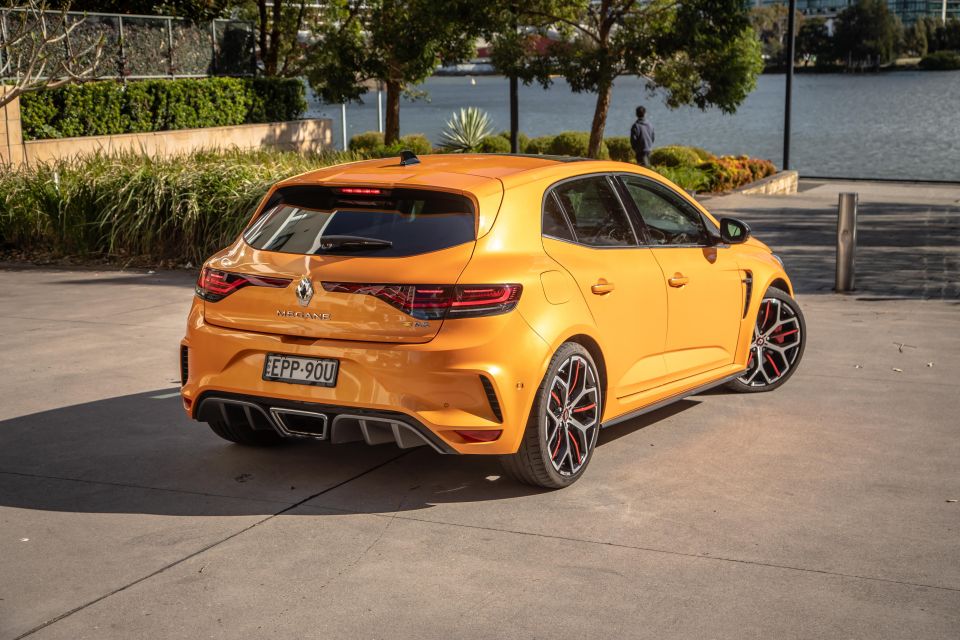

Journalist

Journalist


Journalist

Journalist
Where expert car reviews meet expert car buying – CarExpert gives you trusted advice, personalised service and real savings on your next new car.
Rewind just a handful of years and buyers had a broad choice of Renault Meganes to choose from. In Sport, Cup and Trophy, there was variety of hot and hotter R.S. variants on offer, plus a smaller Clio R.S. or more exotic, technically related mid-engined Alpine A110 cousin.
Come 2022, only one Renault passenger car remains on sale. And in the ultimate Megane R.S. guise, dubbed Trophy, it’s a heck of a last hatch standing.
The Trophy wasn’t the wildest Megane of its now maturing generation – that honour belongs to a couple of limited-edition Trophy-R versions – but it topped a range that kicked off around the $45,000 mark in manual guise.
Now, the only Renault hatchback the Aussie dollar can buy is priced north of $65,000 in automatic EDC-equipped trim.

Like so many car manufacturers, Renault is focusing on an electric future. And you have to wonder if the internal-combustion R.S. brand, with three generations of providence under its sticky tyres and much loved by fanboys and girls globally, is fast approaching its twilight.
Particularly given the next model to wear the Megane nameplate, due for local showrooms next year, is the E-Tech Electric SUV.
It certainly looks the case of getting the Megane R.S. Trophy while it’s hot. And, indeed, it most certainly is.
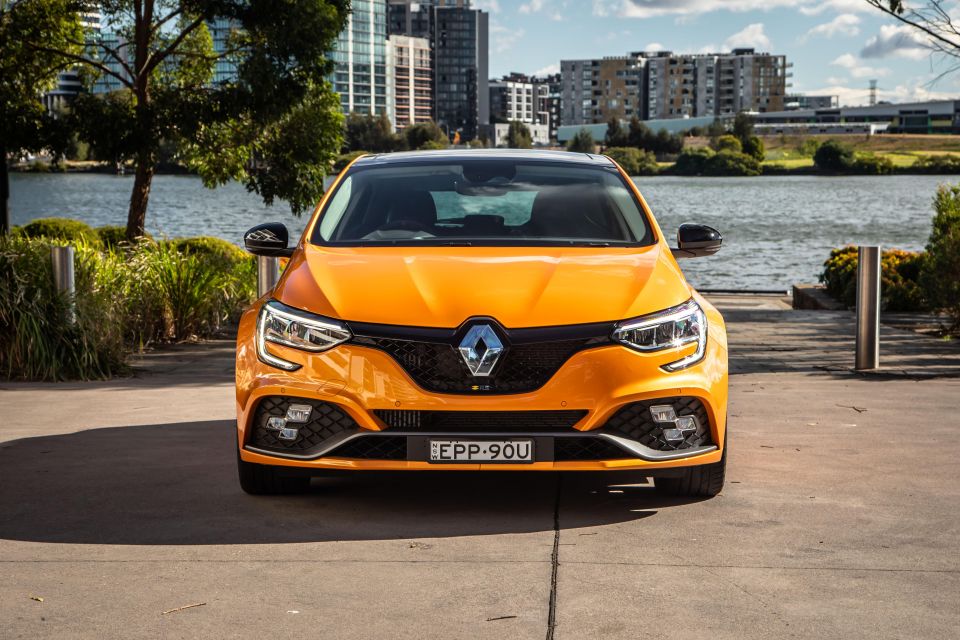
As of July 1 this year, the Megane R.S. Trophy in dual-clutch EDC form is priced from $65,300 before on-roads.
That’s up marginally on the $64,000 price at the time of review (June), and well up on its early 2021 ticket of $56,990 before on-roads, when the Sport and Cup versions were dropped from the line-up and where the remaining Trophy was treated to driver display and multimedia updates for 2021.
Our EDC-equipped test car features options of Signature orange metallic paint ($1000) and electric sunroof ($1990) for a pre-July outlay of $66,990 before on-roads.

The six-speed-manual version of the Trophy is priced from $62,300 as of July 1.
Rivals? Audi’s S3 TFSI quattro ($70,700), and BMW’s front-drive 128ti ($57,900) and M135i xDrive Pure ($66,900), are valid alternatives.
As is the Mercedes-AMG A35 4Matic ($77,689). Hyundai’s top-dog i30 N Premium DCT ($52,500), the Subaru WRX RS Sport auto ($54,490) and Volkswagen Golf R ($65,990) all vie for your small-segment, go-fast dollar at various price points.

Prior to diving inside, it’s worth touching on exterior styling. The plump broad-guard appearance is a real winner to those those who like a thoroughly hot hatchback without juvenile pretensions.
There’s a real maturity in its almost quasi-concept car styling the remains as fetching in today’s Trophy form as when the broader R.S range lobbed years ago. Even if the bold Signature paintwork choices – iridescent yellow or pearl-like orange – are an acquired taste.
The cabin design is a good fit: undeniably French in its style if quite natural in feel, avoiding the excessive weirdness for which French machinery is known. It’s plenty racy.
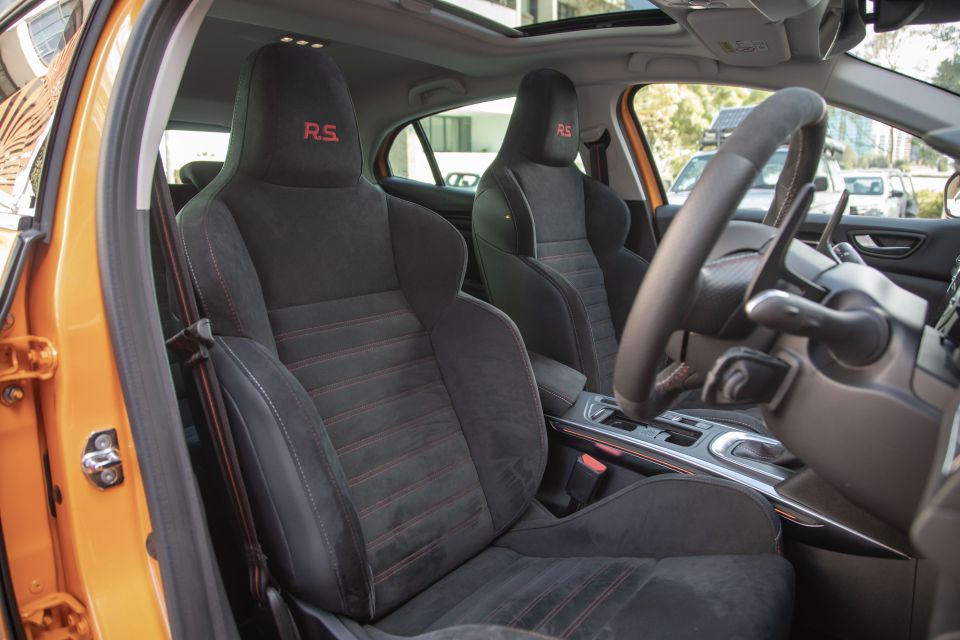

The Trophy’s heavy-handed use of Alcantara for seating and wheel trim is fetching and tactile, though the faux-carbon fibre effect fabric trim verges on gauche.
The seats are wonderfully comfortable yet quite form-hugging, with mechanical adjustment and heating – a typical high-spec hot hatch combo these days – and totally fit for purpose. You can opt for more lightweight Recaros but, really, why bother?
The wheel, too, is chunky but not excessively so, the Alcantara providing excellent heat-of-battle grip. Meanwhile, the ‘elephant ear’ column-mounted paddle shifters are large enough to provide decent access with some steering lock, but don’t offer the mid-corner shifting practicality of the alternative wheel-mounted format.


While it’s reasonably classy and surprisingly solid in effect, some of the cabin is starting to show its age, in areas such as some switchgear, the column mounted audio controls – a Renault quirk – and the transmission selector.
By comparison, it’s a richer fit-out than, say, a Hyundai i30 N and a bit fancier and frillier than the Volkswagen Golf R, albeit without the slickness in its digital displays.
The digital instrumentation is fine enough in look and legibility though the screen is strangely tilted.
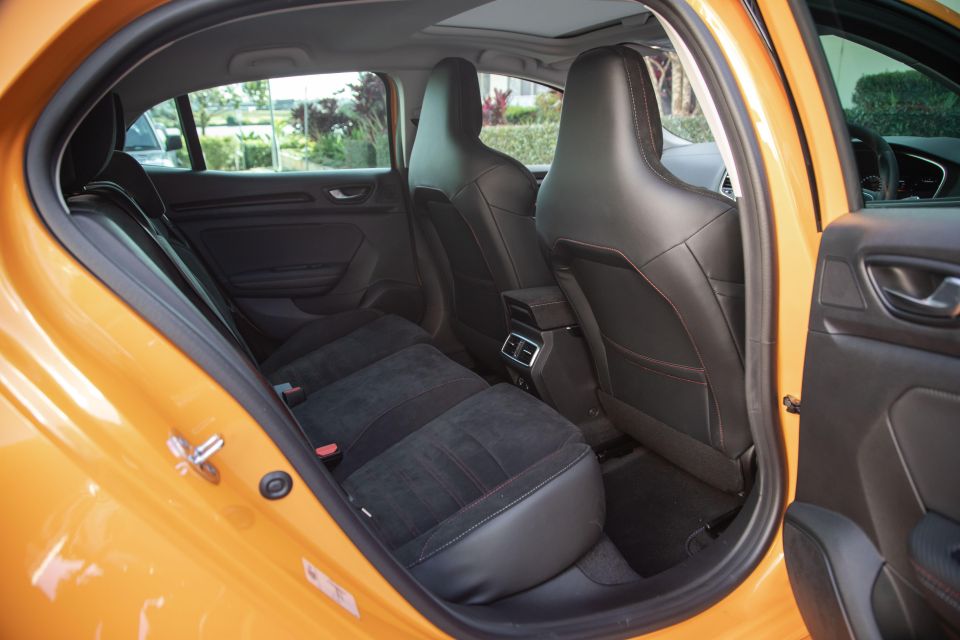

The multimedia screen is a better fit and does a decent job of arranging its content in natural fashion – even using CarPlay – given the portrait orientation.
Dual USB-A ports, dual cupholders, door bins and a tight phone cubby tick the essential convenience boxes without much remark, though the strip mood lighting does bring some frills to a cabin otherwise focused on go-fast purpose.
Second-row accommodation is acceptable in unremarkable for spaciousness and is really a plus-two affair due to the seat contours and prominent hump in the centre of the seat base.


Unlike some hot hatch rivals, the Megane hasn’t skimped on rear passenger niceties such as rear air vents, USB-A ports and 12-volt outlets.
For a machine focused on fun, it’s certainly not impractical and can double-duty as a family runabout if need be. ISOFIX anchor points are fitted and the five-door format brings decent row-two access.
Its 434-litre boot space is also sized decently enough for most everyday lugging duties, though stowing the rear seatbacks demands a bit of front-seat fiddling to allow clearance for the rear headrests. No biggie.

The Trophy features RenaultSport’s ‘300’ (aka 300 horsepower) 1.8-litre turbocharged four, outputting 221kW at 6000rpm. The older ‘280’ R.S. Sport and Cup versions made do with 205kW, with the spec fitted to Trophy altering turbocharger and exhaust hardware.
Both the EDC (aka efficient ‘dual clutch’) automatic and conventional manual transmissions are six-speeds, the former paired to an engine tune delivering 420Nm and the latter offering 400Nm, both peaking at 3200rpm.
So what makes a Trophy? Essentially, it melds the ‘300’ engine and short geared driveline with the big-braked and stiffer-suspended Cup chassis.

The EDC is, at 1443kg kerb, slightly heavier than the manual’s 1420kg. Renault claims identical 5.7-second 0-100km/h claims for both versions, though only the EDC variant has electronic launch control.
At 8.3L/100km combined, the EDC is slightly thirstier than the manual’s 8.0L neat claim. It runs on 98RON fuel in its 50-litre tank.
There’s certainly some trickiness in the Megane R.S. The Sport Cup suspension is passive but features an unusual four hydraulic compression stop design in the damping to enhance wheel control.
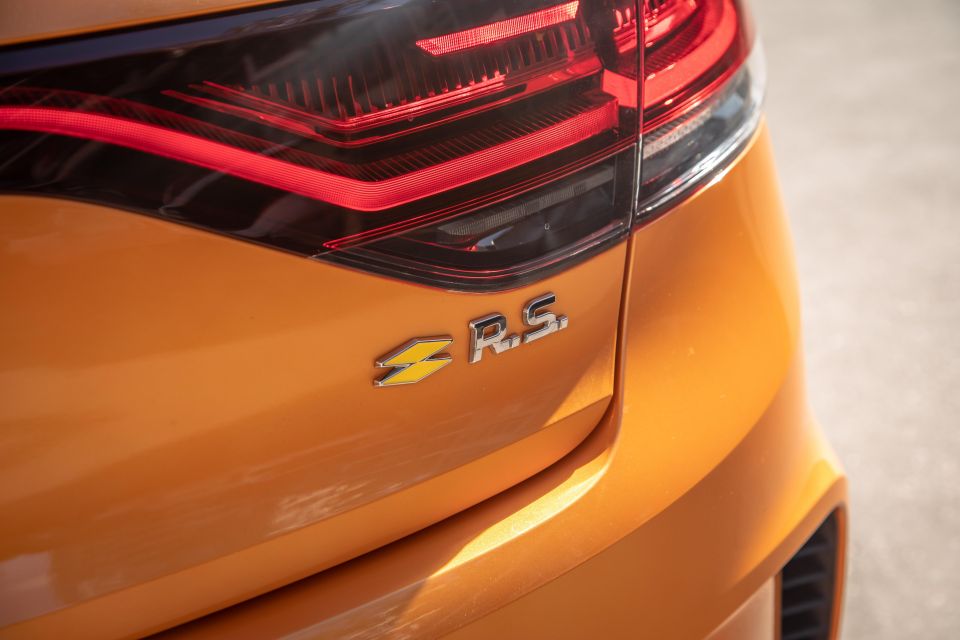
Besides launch control, the EDC version’s multi-downshift is quite nifty, especially for maximum attack driving. It’s reasonably self-explanatory: holding the left paddle shifter under hard braking automatically downshifts through multiple gears to pluck the best ratio for the road speed and for getting back on the power.
Further, the four-wheel-steering system varies shallow rear-steer assistance between opposite and complimentary directions, aiding maneuverability and mid-corner rotation for the former and high-speed stability for the latter.
The transition or changeover point occurs at different road speeds depending on the drive mode chosen.
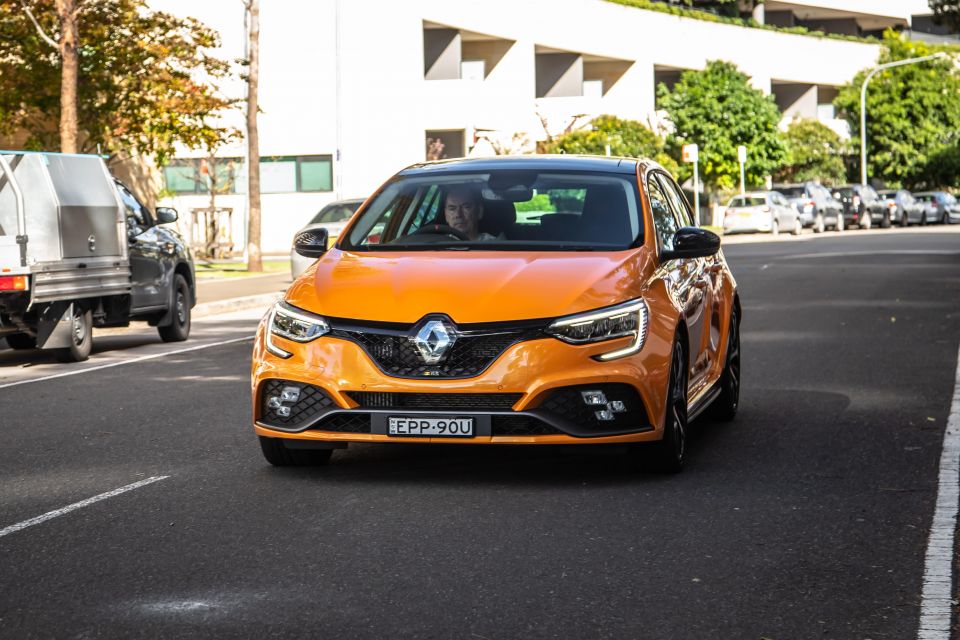
There’s little doubt that between the metallic bark on start-up to the ever-present stiffness of the Cup suspension on the move, the Trophy will happily ditch pleasantries in its pursuit of a red-hot experience.
But it’s not unpleasant at all. The powertrain isn’t highly strung. The ride offered on the Cup chassis for sort of handling promise it brings, is quite palatable.
But there’s little mistaking the Trophy for anything but the most hardcore and focused of what was once a six-variant range. Those after the more tempered Sport chassis have now missed the boat.
As Trophy is the only trim now available, it has a tougher role filling broader on-road shoes given it really was the variant you like choose on-track work. If you do want a daily-driven Megane R.S., of course, this is it.
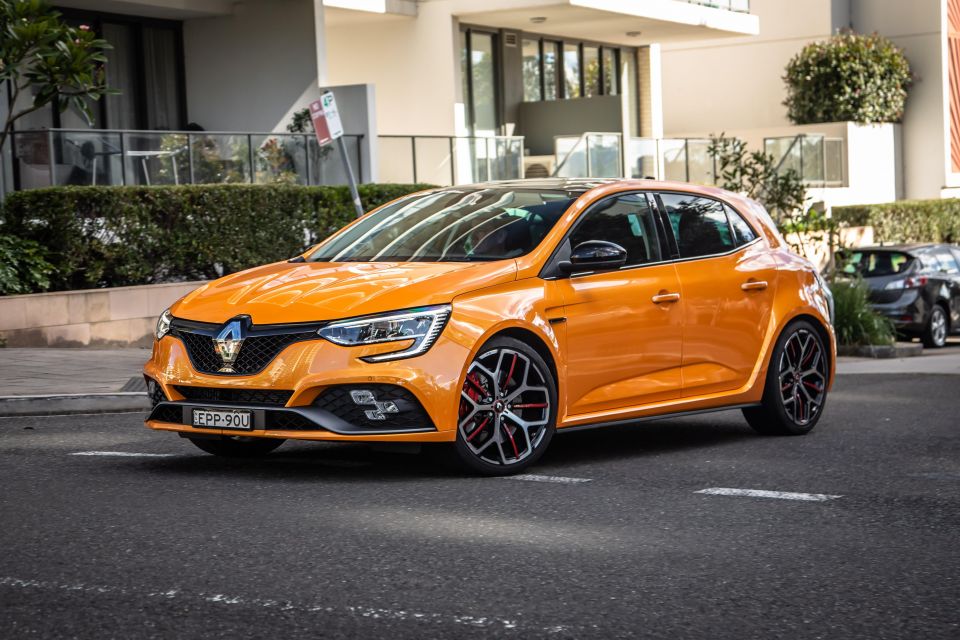
Where expert car reviews meet expert car buying – CarExpert gives you trusted advice, personalised service and real savings on your next new car.
The ‘300’ engine and EDC are a nice combination. The engine, for its part, feels larger than its diminutive 1.8-litre capacity on the boil and it’s a real firecracker on the march, though it does seem to lack some of the instant low-rev torque of some larger-engine rivals.
It has an impressively strident sweet spot, but it swells into it off the mark.
Even then, its energy is such that the front tyres with scrabble around in mild torque steer – not enough to be unruly but just enough to really let you know it’s overcome traction. In fact, the mechanical Torsen LSD effect isn’t quite as assertive as you might expect, at least in a straight line.
All of this does make the Trophy very drivable around town. It’s punchy without digging through drive modes and the dual-clutch gearbox, which doesn’t seem to lack for the seventh ratio offered in some rivals, is wonderfully smooth and clean when self-shifting and amply alert on the paddle shifters.

The Cup chassis always feels flat and planted, its suspension and steering free of flab. There’s a real sense of mechanical connection and a satisfying directness in its response.
The toughest balance the Cup tune needs to strike is ride quality. It’s firm to the point of being rigid at times, its front end damped slightly softer than its terse rear. You need to negotiate speed bumps with care. And across poorer road surfaces, it does become fatiguing on the long haul and could get tiresome on the daily commute.
That said, there is a sheen of compliance from a suspension with seemingly very little wheel travel. Its tricky hydraulic compression stops in the dampers don’t necessarily tame ride quality like an adaptive design would, though they do seem to filter out some nasties and prevent crashing during around town driving.
Of course, the payout arrives on a racetrack or, as tested here, on a twisty back road. It’s a feisty hatchback indeed, one that baits you to push on and rewards handsomely once you do.

At a fair clip, the Trophy is connected yet quite benign and very fluid. You don’t need much input through the hands and feet to drum up some heady pace in quite a relaxed manner.
It flows from one apex to another in a planted and predictable manner, with just enough playfulness in its tail to offer utmost dynamic cooperation without getting unruly.
Lateral grip is fantastic and you really have to dare deep into ‘you’re nicked’ pace if you want to explore the fringes of its handling talent.
Throughout, the engine remains punchy and urgent, and the transmission is an obedient ally, even if the column-mounted paddle shifters inhibit the sort of corner-exit upshifts the dual-clutch transmission usually brings over a conventional manual.
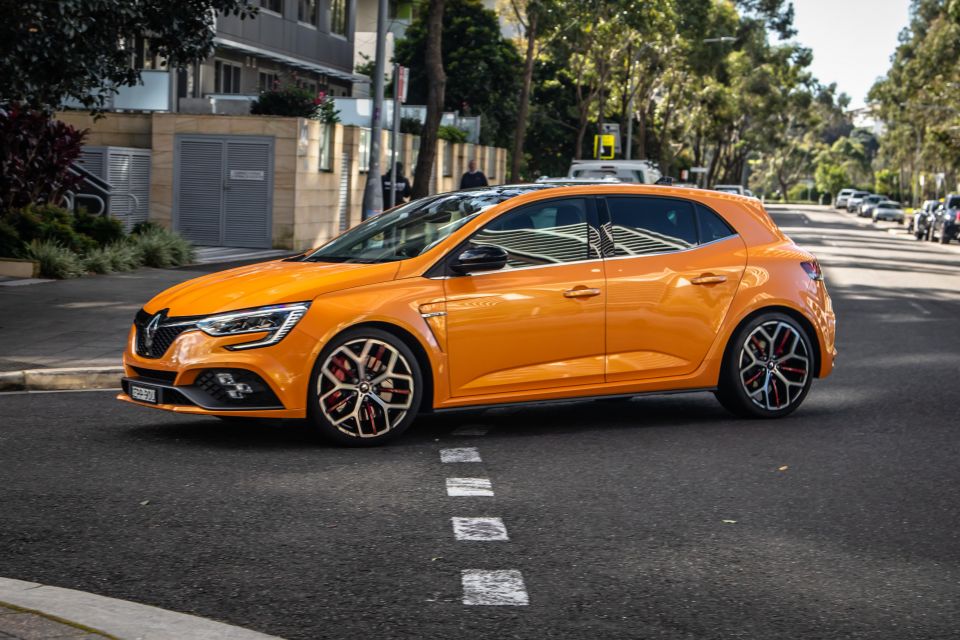
On that, the Megane R.S. manual always featured awkwardly-staggered pedals with a very proud clutch pedal – tough for heel-and-toe frivolity – and having driven the transmissions back-to-back in the past, on road and track, the EDC is undoubted quicker and allows the driver the dig deeper into the engine and chassis harder.
What’s quite interesting is the effect of the all-wheel steering, because it can present two quite different dynamic characters depending on the which drive mode you choose.
In any mode other than Race, the threshold where the rears stop steering opposite front wheels is 60km/h. On a tight road, the amount of extra mid-corner rotation the rear-steer effect brings is quite noticeable: it simply hooks through second-gear hairpins more eagerly than you’d first expect.
Activate Race and the transition from opposite to complimentary rear steering is 100km/h, for added rotation in slower corners and more stability in the faster stuff. And from past experience, it works a treat on track.
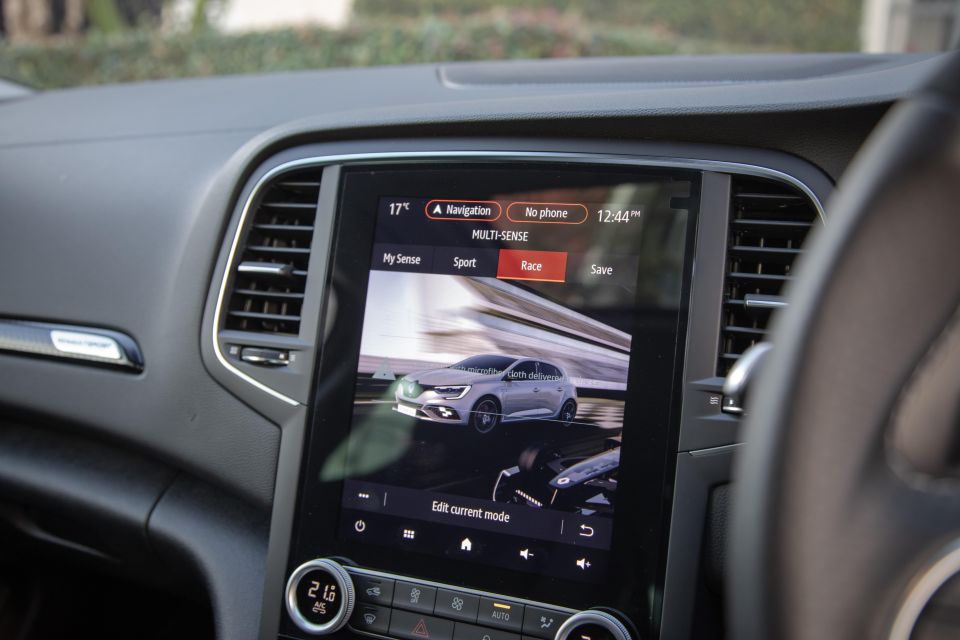
On a twisty road where you rarely hit 100km/h in most corners, Race mode makes for a more lively experience than the other drive modes. That’s because the powertrain is hyper alert and the chassis is almost always teasing extra more chassis rotation mid-corner.
Push on in Race mode and it really starts to grab your attention, and demands the driver stay on top of his or her game.
In short, the Trophy is very potent and damn quick when you ask it to be, with a couple of distinctive dynamic characters to choose from depending on taste, whim or situation.
And yet it’s tempered just enough to be liveable for the lion’s share of drive time when you’re not in a hurry.


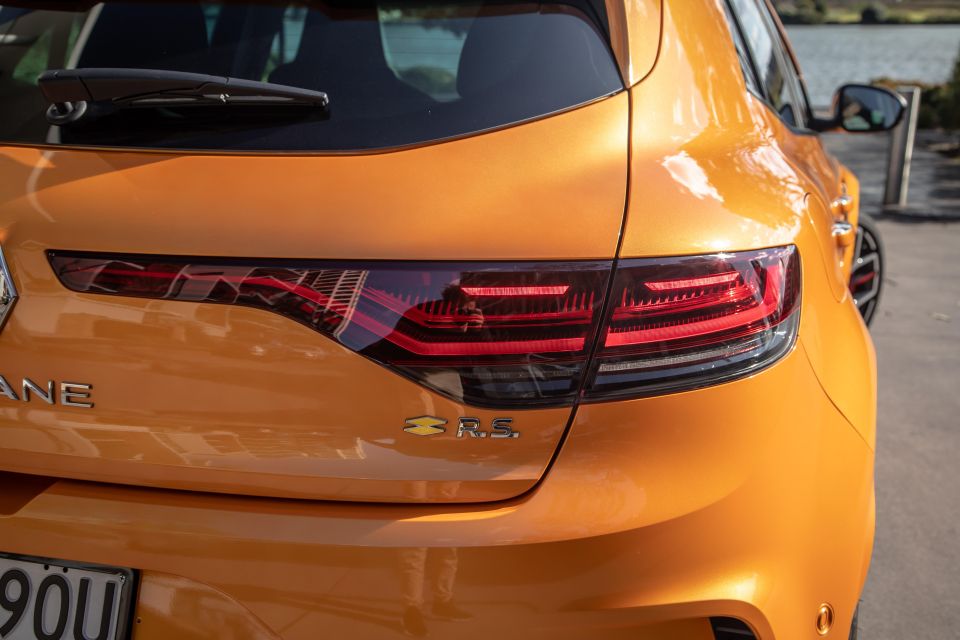

The current version of the R.S. Trophy arrived in early 2021, where the sole remaining Megane model gained a new 10.25-inch driver’s display to replace the old 7.0-inch unit, as well as a new 9.3-inch portrait-oriented multimedia display, up from 8.7 inches.
Low-speed autonomous emergency braking also bolstered the safety fit-out.
Megane R.S. Trophy highlights:
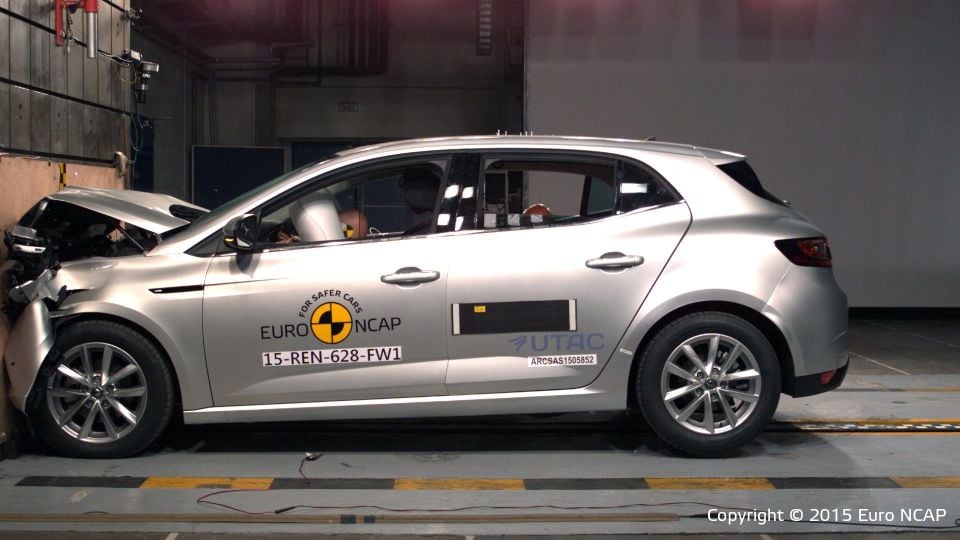
The current fourth-generation Megane has not been tested by ANCAP. However, Euro NCAP awarded the range five stars from assessment back in 2015.
Standard safety features include:

The Megane R.S. Trophy is covered by Renault’s five-year, unlimited-kilometre warranty.
Service intervals are every 12 months and quite lengthy 20,000km intervals, whichever comes first. Each visit is capped at $529 for the first three years, which isn’t too back for a hardcore machine fit for track use.
Claimed combined consumption is 8.0L/100kms for the EDC, with the manual 0.3L thirstier. On test, it averaged comfortably into double figures, though much of the driving was, admittedly, quite enthusiastic.
Unsurprisingly, it does demand 98RON fuel.
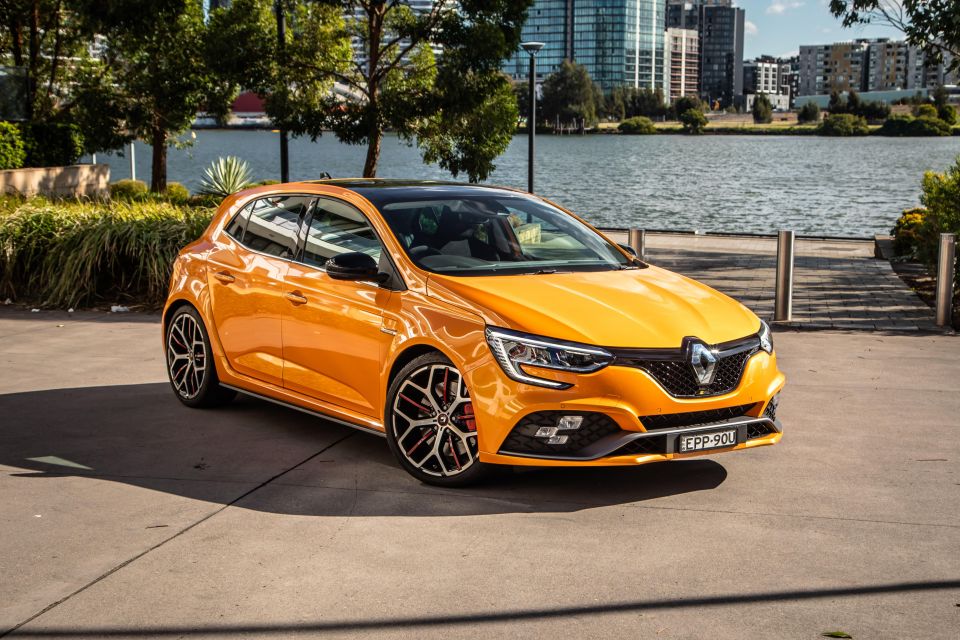
Disclosure: I was lucky enough to attend the third-gen Megane R.S. launch in Spain years ago and I was instantly smitten by it.
Back then you had two choices: Sport EDC or Cup manual only.
After the media and prospective enthusiast buyers grumbled about the lack of a dual-clutch Cup version, it was retrospectively added to the local line-up and was, in your author’s opinion, the most desirable combination.
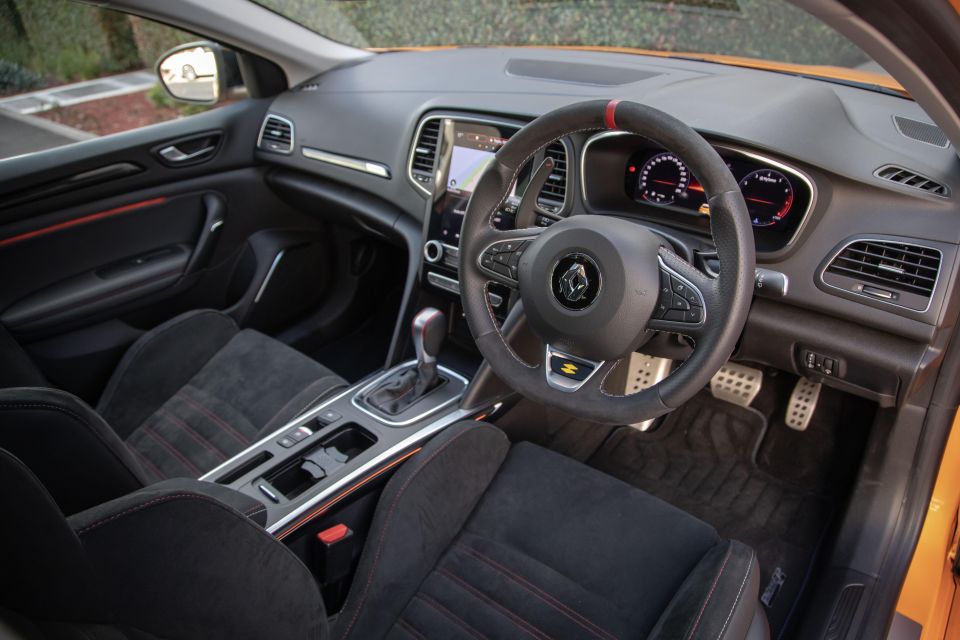
Today, you still get just two choices: the fittest chassis with excellent paddle shift transmission, now with extra Trophy-spec output and accoutrement. Or the manual if that’s your older-school want.
It’s starting to show its age in some areas and, sadly, probably entering its twilight as an iconic hot hatch. But if this is the last chance to see this generation of Megane R.S., the Trophy is the one to have. At least from a heart-pumping and emotional enthusiast perspective.
It’s just a shame that, at around $65,000, buying into the Megane R.S. experience is vastly more expensive than what it was only a few years back.
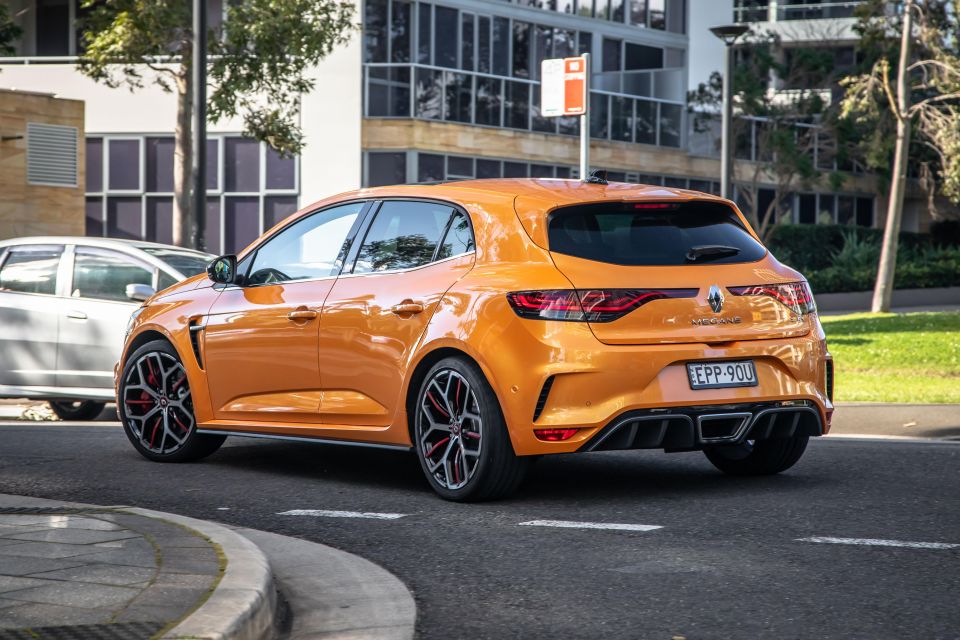
Click the images for the full gallery.
Where expert car reviews meet expert car buying – CarExpert gives you trusted advice, personalised service and real savings on your next new car.


CarExpert.com.au
4 Days Ago
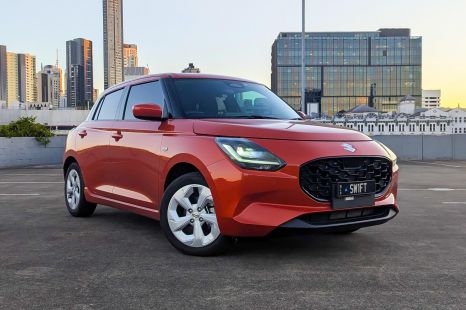

William Stopford
3 Days Ago


Max Davies
2 Days Ago


Josh Nevett
1 Day Ago
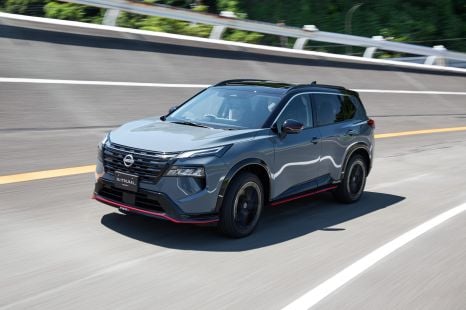

William Stopford
22 Hours Ago


Andrew Maclean
21 Hours Ago